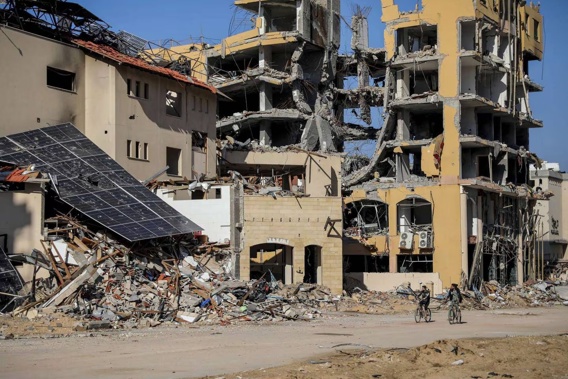
Israel and Hamas today agreed to extend their ceasefire by another day, just minutes before it was set to expire. The truce in Gaza appeared increasingly tenuous as the number of women and children held by the militants as bargaining chips dwindled after dozens were released.
Word of the extension came just as the truce was to expire at 7am Thursday local time (6pm NZT). The Qatari Foreign Ministry said the truce was being extended under the same terms as in the past, with Hamas releasing 10 Israeli hostages per day in exchange for Israel’s release of 30 Palestinian prisoners.
International pressure has mounted for the ceasefire to continue as long as possible after nearly eight weeks of Israeli bombardment and a ground campaign in Gaza that has killed thousands of Palestinians, uprooted three-quarters of the population of 2.3 million and led to a humanitarian crisis.
The war has stoked tensions across the region. Today, two gunmen opened fire on people waiting for buses and rides where a main highway from Tel Aviv enters Jerusalem. Israel’s Maged David Adom emergency service said one person was killed and six people were wounded, one of them critically. Police said the two attackers were killed.
US Secretary of State Antony Blinken has arrived in Israel on his third trip to the region since the start of the war and is expected to press for further extensions of the truce and the release of more hostages.
/cloudfront-ap-southeast-2.images.arcpublishing.com/nzme/33X7EO5PLVDJRM4H2P5ZY5FIWY.jpg)
Palestinians cook bread by their destroyed homes in the Gaza Strip during the temporary ceasefire. Photo / AP
The announcement followed a last-minute standoff, with Hamas saying Israel had rejected a proposed list that included seven living captives and the remains of three who the group said were killed in Israeli airstrikes. Israel later said Hamas submitted an improved list, paving the way for the extension.
The talks appear to be growing tougher with most of the women and children taken hostage by Hamas during the deadly October 7 attack on Israel that triggered the war already freed. The militants are expected to make greater demands in return for freeing men and soldiers.
Israel says it will maintain the truce until Hamas stops releasing captives, at which point it will resume its offensive aimed at eliminating the group.
Hamas is deeply rooted in Palestinian society and has ruled Gaza since 2007. So far, the Israeli onslaught in Gaza seems to have had little effect on the group’s rule, evidenced by its ability to conduct complex negotiations, enforce the truce among other armed groups and orchestrate the release of hostages.
- Hamas releases third group of hostages, says it will seek to extend the deal
- Tense wait for Hamas to release more hostages
- Israeli official says talks continuing, hostage release won't take place before Friday
Hamas leaders, including Yehya Sinwar, have likely relocated to southern Gaza.
With Israeli troops holding much of northern Gaza, a ground invasion south — where most of Gaza’s population is now concentrated — will likely bring an escalating cost in Palestinian lives and destruction.
The Biden administration has told Israel that if it launches an offensive in the south, it must operate with far greater precision.
/cloudfront-ap-southeast-2.images.arcpublishing.com/nzme/NDHPDFTDCFFI5DANZTZP4RTXAI.jpg)
Palestinians ride bicycles by destroyed buildings in Gaza City. Photo / AP
Increasingly tense hostage talks
The plight of the captives and shock from Hamas’ October 7 attack in southern Israel have galvanised Israeli support for the war. But Prime Minister Benjamin Netanyahu is under pressure to bring the hostages home and could find it difficult to resume the offensive if there’s a prospect of more releases.
Since the initial truce began on Friday, both sides have been releasing only women and children. Israeli officials say Gaza militants still hold around 20 women, who would all be released in a few days if the swaps continue at the current rate.
After that, keeping the truce going depends on tougher negotiations over the release of around 126 men Israel says are held captive, including several dozen soldiers.
For men — and especially soldiers — Hamas is expected to push for comparable releases of Palestinian men or prominent detainees, a deal Israel may resist.
So far, most Palestinians released have been teenagers accused of throwing stones and firebombs during confrontations with Israeli forces. Several were women convicted by Israeli military courts of attempting to attack soldiers. Palestinians have celebrated the release of people they see as having resisted Israel’s decades-long military occupation of lands they want for a future state.
An Israeli official involved in hostage negotiations said talks on a further extension for release of civilian men and soldiers were still preliminary, and that a deal would not be considered until all the women and children are out. The official spoke on condition of anonymity because negotiations were ongoing.
With Wednesday’s releases, a total of 73 Israelis, including dual nationals, have been freed during the six-day truce, most of whom appear physically well but shaken. Another 24 hostages — 23 Thais and one Filipino — have also been released. Before the ceasefire, Hamas released four hostages, and the Israeli army rescued one. Two others were found dead in Gaza.
/cloudfront-ap-southeast-2.images.arcpublishing.com/nzme/IFVQKSRFQ5ACFD422O5F3H6IJQ.jpg)
Palestinians walk through a devastated part of Gaza City. Photo / AP
Hamas kidnapped some 240 people during the attack on southern Israel that began the war, including babies, children, women, soldiers, older adults and Thai farm labourers. It killed more than 1200 people in the October 7 attack, mostly civilians.
Israel’s bombardment and ground invasion in Gaza have killed more than 13,300 Palestinians, roughly two-thirds of them women and minors, according to the Health Ministry in Hamas-ruled Gaza, which does not differentiate between civilians and combatants.
The toll is likely much higher, as officials have only sporadically updated the count since November 11 due to the breakdown of services in the north. The ministry says thousands more people are missing and feared dead under the rubble.
Israel says 77 of its soldiers have been killed in the ground offensive. It claims to have killed thousands of militants, without providing evidence.
In Gaza, an anxious respite
For Palestinians in Gaza, the truce’s calm has been overwhelmed by the search for aid and by horror at the extent of destruction.
In the north, residents described entire residential blocks as levelled in Gaza City and surrounding areas. The smell of decomposing bodies trapped under collapsed buildings fills the air, said Mohmmed Mattar, a 29-year-old resident of Gaza City who along with other volunteers searches for the dead under rubble or left in the streets.
In the south, the truce has allowed more aid to be delivered from Egypt, up to 200 trucks a day. But aid officials say it is not enough, given that most now depend on outside aid. Overwhelmed UN-run shelters house more than 1 million displaced people, with many sleeping outside in cold, rainy weather.
At a distribution centre in Rafah, large crowds line up daily for bags of flour but supplies run out quickly.
“Every day, we come here … we spend money on transportation to get here, just to go home with nothing,” said one woman in line, Nawal Abu Namous.
Take your Radio, Podcasts and Music with you









